
Mission San Fernando Rey de España is a Spanish mission in the Mission Hills the district of Los Angeles, California. The mission was founded on September 8, 1797, and was the seventeenth of the twenty-one Spanish missions established in Alta California. Named for Saint Ferdinand, the mission is the namesake of the nearby city of San Fernando and the San Fernando Valley.
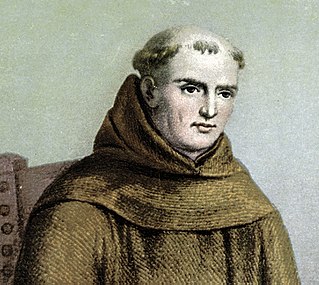
Saint Junípero Serra y Ferrer, O.F.M., was a Roman Catholic Spanish priest and friar of the Franciscan Order who founded a mission in Baja California and the first nine of 21 Spanish missions in California from San Diego to San Francisco, in what was then Alta California in the Province of Las Californias, New Spain. Serra was beatified by Pope John Paul II on September 25, 1988, in the Vatican City. Pope Francis canonised him on September 23, 2015, at the Basilica of the National Shrine of the Immaculate Conception in Washington, D.C., during his first visit to the United States. His missionary efforts earned him the title of Apostle of California.
This timeline of Christian missions chronicles the global expansion of Christianity through a listing of the most significant missionary outreach events.

Bernardino de Sahagún was a Franciscan friar, missionary priest and pioneering ethnographer who participated in the Catholic evangelization of colonial New Spain. Born in Sahagún, Spain, in 1499, he journeyed to New Spain in 1529. He learned Nahuatl and spent more than 50 years in the study of Aztec beliefs, culture and history. Though he was primarily devoted to his missionary task, his extraordinary work documenting indigenous worldview and culture has earned him the title as “the first anthropologist." He also contributed to the description of the Aztec language Nahuatl. He translated the Psalms, the Gospels, and a catechism into Nahuatl.
Juan de Salmerón was a Spanish colonial official New Spain, and an oidor (judge) of the Second Audiencia, which governed the colony from January 10, 1531 until April 16, 1534. On the latter date, the government was turned over to Antonio de Mendoza, the first viceroy. Along with Fray Toribio de Benavente Motolinia he built the first European settlement at Puebla, Puebla.
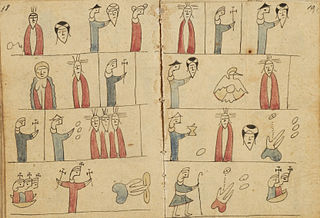
Testerian is a pictorial writing system that was used until the 19th century to teach Christian doctrine to the indigenous peoples of Mexico, who were unfamiliar with alphabetic writing systems. Its invention is attributed to Jacobo de Testera, a Franciscan who arrived in Mexico in 1529.
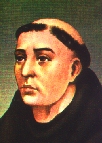
Toribio of Benavente, O.F.M., also known as Motolinía, was a Franciscan missionary who was one of the famous Twelve Apostles of Mexico who arrived in New Spain in May 1524. His published writings are a key source for the history and ethnography of the Nahuas of central Mexico in the immediate post-conquest period as well as for the challenges of Christian evangelization. He is probably best known for his attacks on the Dominican defender of the rights of the indigenous peoples, Bartolomé de las Casas, who criticized the Conquest. Motolinia supported the subjugation of the Indians as savages and did all he could to vilify Las Casas, who tried to protect the Indians' natural rights and full humanity.
Fray Gerónimo de Mendieta (1525–1604), alternatively Jerónimo de Mendieta, was a Franciscan missionary and historian, who spent most of his life in the Spanish Empire's new possessions in Mexico and Central America.

Luis Jayme O.F.M., born Melchor Jayme, was a Spanish-born Roman Catholic priest of the Franciscan Order. Born at the farm Son Baró in the village of Sant Joan, Majorca, his earliest schooling was acquired from the local parish priest. At the age of fifteen Melchor was enrolled at the convent school of San Bernardino, where Fray Junípero Serra had studied some years earlier.
Francisco Pareja was a Franciscan missionary in Spanish Florida, where he was primarily assigned to San Juan del Puerto. The Spaniard became a spokesman for the Franciscan community to the Spanish and colonial governments, was a leader among the missionaries, and served as custodio for the community in Florida. After the Franciscan organization was promoted to a provincia (province), Pareja was elected by his fellow missionaries as provincial in 1616.
Domingo Betanzos was a Spanish Dominican missionary to New Spain, who participated in the "Spiritual Conquest", evangelizing the indigenous.
The Franciscan Missions to the Maya were the attempts of the Franciscans to Christianize the indigenous peoples of the New World, specifically the Maya. They began to take place soon after the discovery of the New World made by Christopher Columbus in 1492, which opened the door for Catholic missions. As early as 1519 there are records of Franciscan activity in the Americas, and throughout the early 16th century the mission movement spreads from the original contact point in the Caribbean to include Mexico, Central America, parts of South America, and the Southwestern United States.

San Francisco de Conchos is a town and seat of the municipality of San Francisco de Conchos, in the northern Mexican state of Chihuahua. As of 2010, the town of San Francisco de Conchos had a population of 644, up from 596 as of 2005.
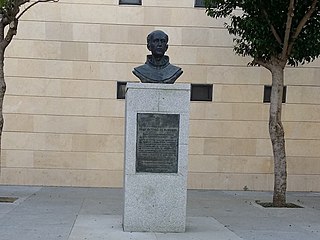
Antonio de San Buenaventura y Olivares or simply Fray Antonio de Olivares was a Spanish Franciscan who officiated at the first Catholic Mass celebrated in Texas, and he was known for contributing to the founding of San Antonio and to the prior exploration of the area.

The Spanish Missions in the Americas were Catholic missions established by the Spanish Empire during the 16th to 19th centuries in areas extending from Mexico and southwestern portions of current-day United States to as far south as Argentina and Chile.
Francisco Martínez de Baeza was the colonial governor of New Mexico from November 1634 to 18 April 1637. He was heavily criticized for rejecting the participation of Franciscan missions in the territory, for impeding the conversion of indigenous people to Christianity, and for exploiting the labor of these people.
Pedro de Aguado was a Spanish Franciscan friar who spent around 15 years in the New Kingdom of Granada, preaching to the indigenous people. During this time he collected source material for a history of the region, and began a manuscript, Recopilación historial, which he completed in Spain between 1576 and 1583 but was unable to publish. The manuscript was used by other historians, but was not published until the twentieth century.

The Testerian catechisms (Spanish: Catecismos testerianos) are religious documents used in the evangelization of the New Spain. They explain the Catholic doctrine through images based on indigenous conventions prior to the Conquest of Mexico and western Spanish writing and other languages. These documents were an attempt to be educative materials for those religious that did not know the aboriginal languages then spoken in the territory that is now Mexico. They received their name for Jacobo of Testera, a Franciscan friar who elaborated catechisms of this type.
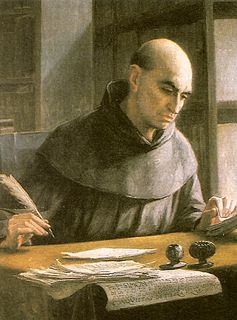
Fray Pedro Simón was a Spanish franciscan friar, professor and chronicler of the indigenous peoples of Colombia and Venezuela, at the time forming the New Kingdom of Granada. Pedro Simón is one of the most important Muisca scholars forming the basis for later scholars such as Lucas Fernández de Piedrahita, Alexander von Humboldt, Javier Ocampo López and many others.
Fray Matías Abad was a Franciscan priest who was martyred in the New World. He was born in the Spanish town of Cueto, in the province of Santander, and died in Uraba on the Atlantic coast of Colombia in January 1649. He was the founder of Franciscan missions in the province of Chocó, Colombia.
















